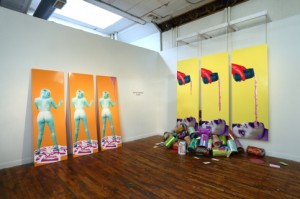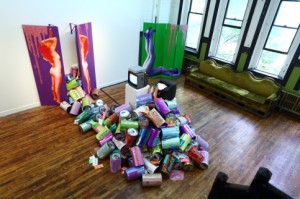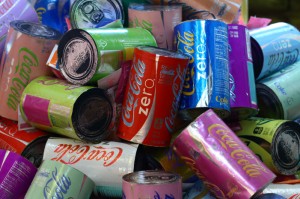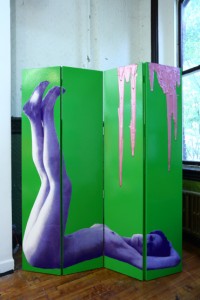—>Alyssa visits Space 1026 for the frank, Pop-art treatment of our crass commercial landscape by Leslie Friedman, one of the founders of the alternative gallery Napoleon. –the Artblog editors—————————->
Leslie Friedman knows her way around a suggestive mise-en-scène. That much is clear after about a millisecond of looking at “Tastier,” her show at Space 1026; from every angle, the pieces deftly skewer the culture of materialism and do it stylishly, with maximum symbolic impact. Using time-honored icons of the culture — naked women, Coca-Cola — and tropes of pop art, “Tastier” is nothing we haven’t seen before. Its arrangement and choice of context, however, transcend cliché and successfully draw visitors into its gleeful crassness.


Both nauseating and tittilating, and that’s the point
“Tastier” is a series of installations staged as scenes. Around the room, mountainous heaps of intermixed Coke Zero cans and Splenda packets sit, presided over by nude women in various states of sexual availability. My immediate reaction? A kind of nauseated titillation. Nobody in their right mind could be enticed by that mess of neon colors, garbage, and overt sexual gimmickry, and perhaps that’s what Friedman wants us to take away.

All aspects of “Tastier” are simulacra– the women preening, the Coke Zero cans screen-printed in candy colors rather than their signature sleek black and red, and the cheerfully-named sugar substitute, Splenda. Friedman’s choice of Coke Zero, Coca-Cola’s allegedly better-for-you offspring, is both contextually smart and necessary in evoking American triumphalism. Symbolic of America’s preference for seeking new sugar substitutes the way scientists seek the cure for cancer, the Coke Zero and Splenda detritus in these works lays bare what we’re still greedily pouring into our bodies, truly believing it to be somehow better than the real thing.

The Splenda packets are a wonderful contemporary touch. Now ubiquitous in restaurants and cafes, how appropriate that this cheerily-named faux-sugar punctuates “Tastier.”

Poking fun at advertising’s use of sex to sell
The brazen sexuality is just as it’s always been in advertising in the porn industry: in your face, with nothing left to the imagination. Here the depictions of women serve two roles: as guardians (see “Sugar Voice”) and as submissive recipients. The folding purple doors are adorned with mirror images of a nude woman stretching her arms over her head, and the doors open to spill a deluge of Coke Zero cans and Splenda packets onto the floor, making the women gatekeepers. But of what? The unbridled gluttonous pleasure of devouring mountains of sugar? Sexual availability to the visitor? It’s not clear, and that’s what Friedman does best: she points to our conflation of carnal, sensual and emotional satisfaction as a most fascinating, if admittedly vile, American trope.

Paint placement is essential to a few pieces here, in cases where the “Tastier” women are frozen in a perpetual open-mouthed reception of pink, globby paint, which for some will resemble bubble gum. Does it need to be laid out that crudely? Maybe not, but it does lend an air of entrapment and domination to “Tastier,” which is another ineffable fact of our consumer culture. We may think that we’re choosing freely, but it’s just the opposite.

Ultimately, Friedman offers no comment on how invested we should be in our quest to swap out the harmful for the allegedly more salutary. She does, however, show how ingrained all of this garish, lustful ad-speak is in life, while raising the question of how these products may either help or hurt our quest for better living.
“Tastier” is at Space 1026 through July 26.









